IGHT T REPLY
Page 217
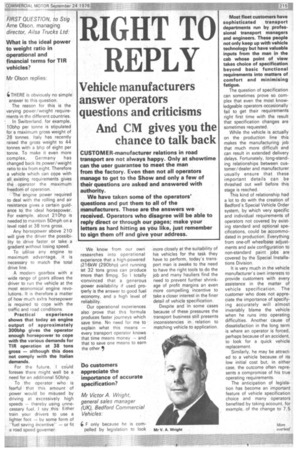
Page 218
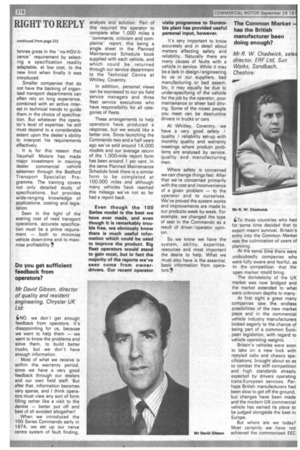
Page 219
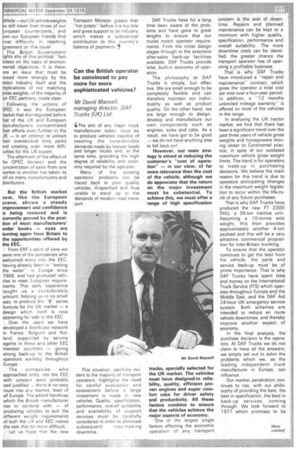
Page 220
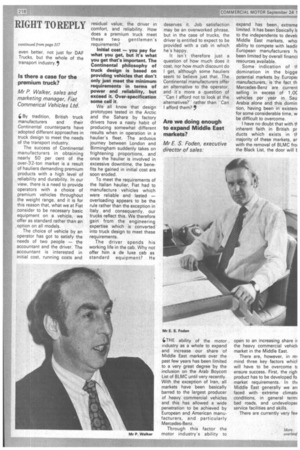
Page 223
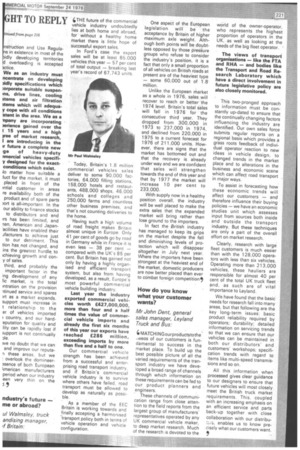
Page 224
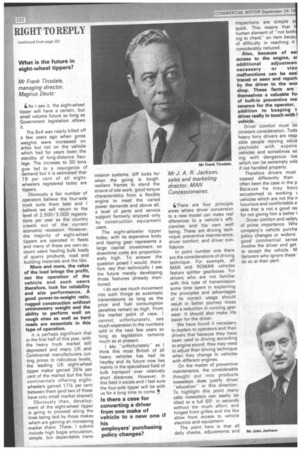
Page 225
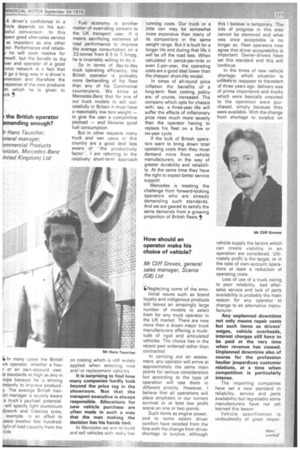
Page 226
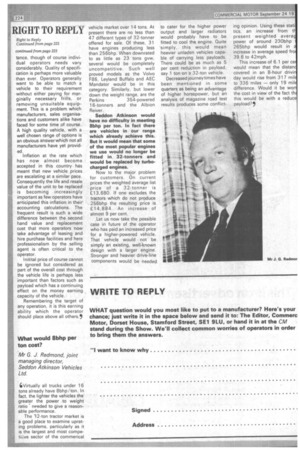
If you've noticed an error in this article please click here to report it so we can fix it.
Vehicle manufacturers answer operators questions and criticisms And CM gives you the chance to talk back
FIRST QUESTION, to Stig Arne Olson, managing director, AiIse Trucks Ltd What is the ideal power to weight ratio in operational and financial terms for TIR vehicles?
THERE is obviously no simple answer to this question.
The reason for this is the varying power/weight requirements in the different countries.
In Switzerland, for example, 10bhp per tonne is stipulated for a maximum gross weight of 28 tonnes. Italy has recently raised the gross weight to 44 tonnes with a bhp of eight per tonne. To make it even more complex, Germany has
changed back its power/weight ratio to six from eight. Therefore
a vehicle which can cope with all existing requirements gives the operator the maximum freedom of operation.
The engine power required to deal with the rolling and air resistance gives a certain guidance to the ideal horsepower. For example, about 210hp is needed to maintain 50mph on a level road at 38 tons gross.
Any horsepower above 210 will give the driver the possibility to drive faster or take a gradient without losing speed.
To utilise any engine to maximum advantage, it is necessary to match the total drive line.
A modern gearbox with a wide range of gears allows the driver to run the vehicle at the most economical engine revolutions, It is therefore a matter of how much extra horsepower is required to cope with the traffic and road conditions.
Practical experience shows that today an engine output of approximately 300bhp gives the operator enough horsepower to cope with the various demands for TIR operation at 38 tons gross — although this does not comply with the Italian demands.
For the future, I could foresee there might well be a need for an additional 50bhp.
To the operator who is fearful that this amount of power would be misused by driving at excessively high speeds — thereby using unne cessary fuel, I say .this: Either train your drivers to use a lighter foot -by some form of "fuel saving incentive" — or fit a road speed governer, We 'know from our own researches into operational experience that a high-powered (216kW (290bhp) unit running tat 32 tons gross can produce Imore than 9mpg. So I totally +convinced that a generous ipower availability if used proiperly is the answer to good fuel 'economy, and a high level of Our operational experiences also prove that this formula produces faster journeys which save time. No need for me to explain what this means — every transport operator knows that time means money — and that to save one means to earn the 'other., more closely at the suitability of his vehicles for the task they have to perform, today's transport man is awake to the need to have the right tools to do the job and many hauliers find the need to prevent further shrinkage of profit margins an even more compelling incentive to take a closer interest in the finer detail of vehicle specification.
Despite and in some cases because of these pressures the transport business still presents inconsistencies in relation to matching vehicle to application. Most fleet customers have sophisticated transport departments run by professional transport managers and engineers. These people not only keep up with vehicle technology but have valuable inputs from the man in the cab whose point of view takes choice of specification beyond basic functional requirements into matters of. comfort and minimising fatigue.
The question of specification can sometimes prove so complex that even the most knowledgeable operators occasionally fail to get their requirements right first time with the result that specification changes are sometimes requested.
While the vehicle is actually on the production line this makes the manufacturing job that much more difficult and can result in extended delivery delays. Fortunately, long-standing relationships between customer/dealer and manufacturer usually ensure that these important details can be thrashed out well before this stage is reached.
This kind of relationship had a lot to do with the creation of Bedford's Special Vehicle Order system, by which very specific and individual requirements of operators not covered by existing standard and optional specifications, could be accommodated in production. Everything from one-off wheelbase adjustments and axle configuration to non-standard paint jobs are covered by the Special Installations Division.
It is very much in the vehicle manufacturer's own interests to provide customers with every assistance in the matter of vehicle specification. The customer who does not appreciate the importance of specifying accurately will almost invariably blame the vehicle when he runs into operating difficulties. Another cause of dissatisfaction in the long term is where an operator is forced, perhaps because of an accident, to look for a quick vehicle replacement.
Similarly, he may be attracted to a vehicle because of its low initial cost but, in either case, the outcome often represents a compromise of his true operating requirements.
The anticipation of legislation has become an important feature of vehicle specification choice and many operators benefited by taking account, for example, of the change to 7,5 tonnes gross in the "no-HGV-Iicence" requirement by selecting a specification readily adaptable, at low cost, to the new limit when finally it was introduced.
Smaller companies that do not have the backing of organised transport departments can often rely on long experience, .combined with an active interest in technical trends to guide them in the choice of specification. But whatever the operator's level of expertise, he still must depend to a considerable extent upon the dealer's ability to interpret his requirements effectively.
It is for this reason that Vauxhall Motors has made major investment in training dealer commercial vehicle salesmen through the Bedford Transport Specialist Programme. The training covers not only detailed study of specifications, but provides wide-ranging knowledge of applications, costing and legislation.
• Seen in the light of the soaring cost of road transport operations, accurate specification must be a prime requirement — both to minimise vehicle down-time and to maximise profitability., ;NO, we don't get enough feedback from operators. It's disappointing for us, because we want to help them — we want to know the problems and solve them, to build better trucks, but we don't have enough information.
Most of what we receive is within the. warranty period, since we have a very good feedback through our dealers and our own field staff. But after that, information becomes very sparse, and I think operators must view any sort of form filling rather like a visit to the dentist — better put off and best of all avoided altogether!
When we introduced the 100 Series Commando early in 1974, we set up our nerve centre system of fault finding, analysis and solution. Part of this required the operator to complete after 1,000 miles a "comments, criticism and complaints" report, this being a single sheet in the Planned Maintenance Schedule book supplied with each vehicle, and which could be returned through our service department to the Technical Centre at Whitley, Coventry.
In addition, personal views can be expressed to our six field service managers and three fleet service executives who have responsibility for all categories of fleets.
These arrangements to help operators have produced a response, but we would like a better one. Since launching the Commando two and a half years ago we've sold around 14,000 models and our average return of the 1,000-mile report form has been around 1 per cent. In the same Planned Maintenance Schedule book there is a similar form to be completed at 100,000 miles and although many vehicles have reached this mileage we've not so far had a report back.
Even though the 100 Series model is the best we have ever made, and even though it is remarkably trouble free, we obviously know there is much useful information which could be used to improve the product. Big fleet operators would stand to gain most, but in fact the majority of the reports we've seen come from ownerdrivers. Our recent operator visits programme to Dunstable plant has provided useful personal input, however.
It's very important to know accurately and in detail about matters affecting safety and reliability. Naturally there are many causes of faults with a vehicle in service. While it may be a lack in design/engineering by us or our suppliers, bad manufacturing or bad assembly, it may equally be due to under-specifying of the vehicle for the job by the operator, poor maintenance or sheer bad driving. Some of the nicest people you meet can be destructive drivers in trucks or cars.
At Whitley, Coventry, we have a very good safety / quality / reliability set-up with monthly quality and warranty meetings where product problems are analysed by service, quality and manufacturing men.
Where safety is concerned we can change things fast. After that we're concerned primarily with the cost and inconvenience of a given problem — to the operator and to ourselves. We've proved the system works and improvements are made to our products week by week. For example, we changed the type of seat in the Commando as a result of driver/operator opinion.
So we know we have the system, ability, expertise, resources and most important the desire to help. What we must also have is the essential, basic information from operators.,
The Common Market has the British manufacturer been doing enough?
Mr R. W. Chadwick, sale director, ERF Ltd, Sun Works, Sandbach, Cheshire..
To those countries who had for some time decided that to export meant survival, Britain's entry into the Common Market was the culmination of years of
plant the same A
same time there were undoubtedly companies who were fully aware and fearful, as to the competition that the open market could bring.
The domesticity of the UK market was now bridged and the market extended to what were unknown depths to many.
At first sight a great many companies saw the endless possibilities of the new market place and in the commercial vehicle industry manufacturers looked eagerly to the chance of being part of a common European legislation, with regard to vehicle operating weights.
Britain's vehicles were soon to take on a new look with restyled cabs and chassis specifications, brought about so as to combat the stiff competition and high standards already expected by drivers operating trans-European services. Perhaps British manufacturers had been slow to get off the ground, but changes have been made and the modern UK commercial vehicle has earned its place to be judged alongside the best in Europe.
But where are we today? Most certainly we have not achieved the commonised EEC ehicle —our UK veh icle weights re still lower than those of our uropean counterparts, and en our European friends find reat difficulty in reaching greement on this issue!
The British Government ights shy of this political "hot-. )otato on the basis of environnental objections. It is thereore an issue that must be foiced more strongly by the notor industry itself and the mplications of not matching gross weights, of the majority of gur EEC partners, made clear.
Following the actions of )PEC it was the European narket that disintegrated before hat of the UK and European nanufacturers concentrated heir efforts even further in the JK —• in an attempt to unload heir overstocked lorry parks Ind creating even more cliff-, :ulties for the UK export.
The aftermath of the effect of he OPEC decision and the :oncentration of sales from one narket to another has taken its oil on many manufacturers and iistributors.
But the British market now, like the European scene, shows a steady improvement and confidence is being restored and is currently proved by the position of most manufacturers' order books — eyes are turning again from Britain to the opportunities offered by the EEC.
From ERF's point of view we were one of the companies who welcomed entry into the EEC, having already been in "testing the water" in Europe since 1968, and had produced vehicles to meet European requirements. This early experience taught us a considerable amount, helping us in no small way, to produce the "B" series formula for the UK market — a design which itself is now appearing for sale to the EEC.
Over the years we have developed a distributor network in France, Belgium and Holland, supported by service agents in these and other EEC member countries — giving strong back-up to the British operators working throughout Europe.
The companies who approached entry into the EEC with concern were probably well justified — there is no easy route into any market, least of all Europe. The added handicap which the British manufacturer has to contend with — of producing vehicles to suit the different weight requirements of both the UK and EEC makes the task that bit more difficult.
Let us hope that the new Transport Minister grasps that "hot potato" before it is too late and gives support to an industry which makes a substantial contribution to this country's balance of payments.,
Can the British operator be convinced to pay more for more sophisticated vehicles?
Mr David Mansell, managing director, DAF Trucks (UK) Ltd..
. .
The aim of any major truck manufacturer today must be to produce vehicles capable of meeting the considerable demands made by heavier loads and longer routes and, at the same time, providing the high degree of reliability and economy required by the operator.
Many of the existing operators' problems can be traced back to poor quality vehicles, ill-specified and thus unable to stand up to the demands of modern road transport.
This situation, painfully evident to the majority of transport operators, highlights the need for careful evaluation and assessment before a large investment is made in new vehicles. Quality, specification, performance, overall suitability and availability of support services must he carefully considered in order to eliminate subsequent loss-making downtime. DAF Trucks have for a long time been aware of the problems and have gone to great lengths to ensure that our trucks match operator requirements. From the initial design stages through to the extensive after-sales back-up facilities available, DAF Trucks provide total, built-in economy of operation.
The philosophy at DAF Trucks is simple, but effective. We are small enough to be completely flexible and can therefore maintain our individuality as well as product quality. On the other hand, we are large enough to design, develop and manufabture our own components such as engines, axles and cabs. As a result, we have got to be good — we do not have anything else to fall back on!
However, our main strategy is aimed at reducing the customer's "cost of operation" — in our view, of far more relevance than the cost of the vehicle, although we do appreciate that the return on the major investment must be substantial. To achieve this, we must offer a range of high specification trucks, specially selected for the UK market. The vehicles must have designed-in reliability, quality, efficient proven engines and super comfort cabs for driver safety and productivity. All these factors combine to ensure that the vehicles achieve the major aspects of economy.
One of the largest single factors affecting the economic operation of any transport
concern is the cost of downtime. Repairs and planned maintenance can be kept to a minimum with higher quality, specification, performance and' overall suitability. The more downtime costs can be identified, the greater chance the transport operator has of operating a profitable business.
That is why DAF Trucks have introduced a "repair and maintenance" contract, which gives the operator a total cost per mile over a four-year period. In addition, a "12 months unlimited mileage warranty" is offered on most of the vehicles in the range.
In analysing the UK tractor market, we find that there has been a significant trend over the past three years of vehicle gross weights and horsepowers moving closer to Continental practice, in spite of our outdated maximum vehicle gross weight limits. The trend is for operators to trade-up in purchasing decisions. We believe the main reason for this trend is due to operators anticipating Changes in the maximum weight legislation to occur within the life-cycle of any future purchases.
That is why DAF Trucks have produced the new FT 2300 DHU, a 36-ton tractive unit. Assuming a 10-tonne axle weight, this then provides approximately another 4-ton payload and this will be a very attractive commerical proposition for inter-Britain trunking.
To ensure that the operator continues to get the best from his vehicle, the parts and service back-up must be of prime importance. That is why DAF Trucks have spent time and money on the International Truck Service (ITS) which operates throughout Europe and the Middle East, and the DAF Aid 24-hour UK emergency service system. Both schemes are intended to reduce en route vehicle downtimes, and thereby improve another aspect of economy.
In the final analysis, the purchase decision is the operators. At DAF Trucks we do not claim to have all the answers; we simply set out to solve the problems which we, as the leading independent truck manufacturer in Europe, can influence.
Our market penetration continues to rise, with our philosophy of providing the best, the best in specification, the best in back-up services, coming through. We look forward to 1 977 which promises to be even better, not just for OAF Trucks, but the whole of the transport industry.,
Is there a case for the premium truck?
Mr P. Walker, sales and marketing manager, Fiat Commerical Vehicles Ltd.
By tradition, British truck manufacturers and their Continental counterparts have adopted different approaches in truck design to meet the needs of the transport industry.
The success of Continental manufacturers in obtaining nearly 50 per cent of the over-32-ton market is a result of hauliers demanding premium products with a high level of reliability and durability. In our view, there is a need to provide operators with a choice of premium vehicles throughout the weight range, and it is for this reason that, what we at Fiat consider to be necessary basic equipment on a vehicle, we offer as standard rather than an . option on all models.
The choice of vehicle by an operator has got to satisfy the needs of two people — the accountant and the driver. The accountant is interested in initial cost, running costs and residual value; the driver in comfort, and reliability. How does a premium truck meet these two gentlemen's requirements?
Initial cost — you pay for what you get, but it's what you get that's important. The Continental philosophy of truck design is based on providing vehicles that don't only just meet the minimum requirements in terms of power and reliability, but exceed it. Over-specification some call it.
We all know that design prototypes tested in the Arctic and the Sahara by factory drivers have a nasty habit of producing somewhat different results when in operation in a haulier's fleet. The arduous journey between London and Birmingham suddenly takes on frightening proportions, and once the haulier is involved in excessive downtime, the benefits he gained in initial cost are soon eroded.
To meet the requirements of the Italian haulier, Fiat had to manufacture vehicles which were reliable and lasted — overloading appears to be the rule rather than the exception in Italy and consequently, our trucks reflect this. We therefore gain from the engineering expertise which is convened into truck design to meet these requirements.
The driver spends his working life in the cab. Why not offer him a de luxe cab as standard equipment? He deserves it. Job satisfaction may be an overworked phrase, but in the case of trucks, the driver is entitled to expect to be provided with a cab in which he's happy.
It isn't therefore just a question of how much does it cost, nor how much discount do I get, although some hauliers seem to believe just that. The Continental manufacturers offer an alternative to the operator, and it's more a question of -Can I afford not to look at the alternatives?" rather than ''Can I afford them? 9 Are we doing enough to expand Middle East markets?
Mr E. S. Foden, executive director of sales:
THE ability of the motor industry as a whole to expand and increase our share of Middle East markets over the past few years has been limited to a very great degree by the inclusion on the Arab Boycott List of BLMC until very recently. With the exception of Iran, all markets have been basically barred to the largest producer of heavy commercial vehicles and this has allowed a wide penetration to be achieved by European and American manufacturers, and particularly Mercedes-Benz.
Through this factor the motor industry's ability to expand has beenextreme limited. It has been basically 1€ to the independents to develc Middle East markets, who: ability to compete with leadir European manufacturers h; been limited by overall financi resources_ available.
Some indication of tt domination in the bigge potential markets by Europet manufacturers, is the fact th Mercedes-Benz are current selling in excess of 1,0C vehicles per year in Sau Arabia alone and this domin tion, having been in existenc for some considerable time, w be difficult to overcome.
I have no doubt that with tt inherent faith in British. pr ducts which exists in if majority of these markets, ar with the removal of BLMC fro; the Black List, the door will E open to an increasing share ir the heavy commercial vehicic market in the Middle East.
There are, however, in m, mind three key factors whict will have to be overcome t( ensure success. First, the righ product has to be developed fo market requirements. In th( Middle East generally we arc faced with extreme climatic conditions, in general term! bad roads, and undevelopec service facilities and skills.
There are currently very fev,
Istruction and Use Regula is in existence in most of the idly developing territories I overloading is accepted ctice.
Ne as an industry must tcentrate on developing idly specifications which orporate suitable suspenns, drive lines, cooling Items and air filtration items which will adequaf cope with all conditions stent in the area. We as a npany are incorporating mrience gained over the t 15 years and a high Kee of market research, I are introducing in the ir future a complete new go of heavy-duty nmercial vehicles specifiy designed for the exactconditions which exist.
lo matter how suitable a filet for the market, it must placed in front of the ntial customer in areas re availability both of the product and of spare parts )ort is all-important. In the our ability to finance stocks to distributors and end irs has been limited, and ran, American and Japanbcilities have enabled their Jfacturers to achieve just
to our detriment. This tion has not changed, and ins the greatest hurdle to ichieving growth and cony of sales.
third, and probably the important factor in the ing development of any fic market, is the total intration on the provision itinued service and spares el as a market expands. support must increase in t relationship to the er of vehicles imported country, and our hardeputation for quality and lity can be rapidly lost if ;upport is not continually ale.
we no doubt that we can and improve our repute these areas, but we overlook the domineerasence of both European kmerican manufacturers period when our industry een very thin on the
ndustry's future — me or abroad?
ul Walmsley, truck andising manager, If Britain:
THE future of the commercial vehicle industry undoubtedly lies at both home and abroad, for without a healthy home market there is little hope of successful export sales.
In Ford's case the export sales will be at least 85,000 vehicles this year —57 per cent of total output — breaking last year's record of 67,743 units.
Today, Britain's 1.8 million commercial vehicles sales deliver to some 90,000 factories, 64,000 filling stations, 158,000 hotels and restaurants, 488,000 shops, 46,000 schools and colleges and 250,000 farms and countless other business premises, and that's not counting deliveries to the home.
Having such a high volume of road freight makes Britain almost unique in Europe. Only 41 per cent of goods go by road in Germany while in France it is even less — 38 per cent — compared with the UK's 85 per cent. But Britain has gained not only by having a highly organ ised and efficient transport system, but also from having developed, as a result, Europe's most powerful commercial vehicle building industry.
Last year the industry exported commercial vehi cles worth £427,000,000, more than four and a half times the value of commer cial vehicle imports and already the first six months of this year our exports have reached £286 million, exceeding imports by more than five and a half to one.
Our commercial vehicle strength has been achieved from a successful and enter prising road transport industry, and if Britain's commercial vehicle industry is to survive where others have failed, road transport must be allowed to develop as naturally as possible.
As a Member of the EEC Britain is working towards and
finally accepting a harmonised -transport policy both in terms of vehicle operation and vehicle configuration.
One aspect of the European legislation will be the acceptance by Britain of higher maximum axle weight. Although both points will be doubtless opposed by those pressure groups who refuse to consider the industry's position, it is a fact that only a small proportion of all vehicles on British roads at present are of the heaviest type some 60,000 out of 1.8 million.
Unlike the European Market as a whole in 1976, sales will recover to reach or better the 1974 level. Britain's total sales will fall in 1976 for the consecutive third year. They dropped from 300,000 in 1973 to 237,000 in 1974, and declined from 220,000 in 1975 to a current forecast for 1976 of 211,000 units. However, there are signs that the market has bottomed out and that the recovery is already under way and we are confident that sales will strengthen towards the end of this year and that by 1977 the market will increase 10 per cent to 233,000.
With supply now in a healthy position overall, the industry will be well placed to make the extra sales that the expanded market will bring rather than lose ground to the importers.
In fact the British industry has managed to keep its grips on the market despite the fall and diminishing levels of protection which will disappear altogether in July next year. Where the importers have been strongest at the heaviest end of the market, domestic producers are now better placed than ever to combat foreign competition,
How do you know what your customer wants?
Mr John Dent, general sales manager, Leyland Truck and Bus: MATCH I NG ourproductstothe. ieeas of our customers is fundamental to success in the market place. To build up the best possible picture of all -the varied requirements of the transport industry we have developed a broad range of channels through which information on these requirements can be fed to our product planners and .engineers.
These channels of communication range from close attention to the field reports from the largest group of manufacturers' representatives operated by any UK commercial vehicle maker, to deep market research. Much of the research is devoted to the world of the owner-operator, who represents the highest proportion of operators in the UK, as well as looking at the needs of the big fleet operator.
The views of transpori organisations — like the FTA and RHA — and bodies like the Transport and Road Research Laboratory which have a direct involvement in future legislative policy are also closely monitored.
This two-pronged approach to information must be constantly up-dated to ensure that the continually changing factors influencing the industry are identified. Our own sales force submits regular reports on a regional basis which provides a grass roots feedback of individual operator reaction to new ideas in vehicle design, to changed trends in the market place and to alterations in the business and economic scene which can affect road transport in major ways.
To assist in forecasting how these economic trends will affect our customers — and therefore influence their buying policies — we have an economic studies unit which assesses input from sources both inside and outside the transport industry. But these techniques are only a part of the overall effort on market research.
Clearly, research with large fleet customers is much easier than with the 128,000 operators with less than six vehicles. Operating more than 213,000 vehicles, these hauliers are responsible for almost 40 per cent of the total UK truck fleet and, as such are of vital importance to Leyland.
We have found that the basic needs for research fall into many areas, but that following are the key long-term issues: basic product reliability required by operators; durability; detailed information on servicing trends so that we can ensure that our vehicles can be maintained in both our distributors' and customers' workshops; specification trends with regard to items like multi-speed transmissions and so on.
All this information when processed gives clear guidance to our designers to ensure that future vehicles will most closely meet the British truck market requirements. This, coupled with an increasing emphasis on an efficient service and parts back-up together with close collaboration with our distribut:.”-s, enables us to know precisely what our customers want. What is the future in eight-wheel tippers?
Mr Frank Tinsdale, managing director, Magirus Deutz;
As I see it, the eight-wheel tipper will have a certain, but small volume future so long as Government legislation allows it.
The 8x4 was nearly killed off a few years ago when gross weights were increased on artics but not on the vehicle which had for years been the standby of long-distance haulage. The increase to 30 tons gvw led to a resurgence of demand but it is estimated that 79 per cent of all eightwheelers registered today are tippers.
Obviously a fair number of operators believe the four-axle truck suits them best and I believe we will return to the level of 2,500/3,000 registrations per year as the country crawls out of the current economic recession. However, the majority of eight-wheel tippers are operated in fleets and many of these are own-account users hauling bulk loads of quarry products, road and building materials and the like.
More and more, the value of the load brings the profit, not the operation of the vehicle and such users therefore, look for reliability and site performance. A good power-to-weight ratio, rugged construction without unnecessary weight and the ability to perform well on rough sites as well as hard roads are essentials in this type of operation.
It is perhaps significant that in the first half of this year, with the heavy truck market still depressed and many UK and Continental manufacturers cutting prices to ridiculous levels, the leading UK eight-wheel tipper maker gained 263/4 per cent of the market but the four continentals offering eightwheelers gained 171/4 per cent between them (and two of these have only small market shares!) Obviously then, development of the eight-wheel tipper is going to proceed along the lines being laid by those makes which are gaining an increasing market share. These, I submit include high bogie articulation, simple, but dependable trans
mission systems, diff locks for when the going is tough, resilient frames to stand the strains of site work, good torque characteristics from a flexible engine to meet the varied power demands and above all, a level of parts and service support formerly enjoyed only by construction equipment users.
The eight-wheeler tipper today, with its expensive body and tipping gear represents a large capital investment so downtime costs are proportionately high. To answer the question posed I would, therefore, say that technically I see the future merely developing those features already mentioned.
I do not see much movement into such things as automatic transmissions so long as the price and fuel consumption penalties remain so high. From the market point of view, I cannot, unfortunately, see much expansion in the numbers sold in the next few years so long as legislation remains much as at present.
I say "unfortunately" as I think this most British of all heavy vehicles has had its heyday and its future now lies mainly in the specialised field of bulk transport over relatively short distances. However, in this field it excels and I feel sure the four-axle tipper will be with us for a long time to come.,
Is there a case for converting a driver from one make of vehicle to a new one if his employers' purchasing policy changes? MrJ. A. R. Jackson, sales and marketing director, MAN Concessionaires.
There are four principle areas where driver conversion to a new model can make real diferences to a vehicle's efficiencies and his own well being. These are driving technique; preventive maintenance; driver comfort; and driver confidence.
In point number one there are the considerations of driving technique. For example, all MAN and ROMAN vehicles feature splitter gearboxes. For drivers who are not familiar with this type of transmission some time spent in explaining the principles and advantages of its correct usage should result in better journey times and a reduction in running gear wear. It should also make life easier for the driver.
We have found it necessary to explain to operators,and their drivers that 'because they have been used to driving according to engine sound, they may need to adjust their driving technique when they change to vehicles with different engines.
On the matter of preventive maintenance, the considerable thought put into products nowadays does justify driver "education" in this direction. To highlight this point many cabs nowadays can easily be tilted to a full 60"' in seconds without too much effort, and hinged front grilles and the like allow front access to vehicle electrics and equipment.
The point here is that all daily checks, adjustments and inspections are simple a quick. This means that 1 human element of "not both ing to check" an item becat of diffibulty in reaching it considerably reduced.
Also, because of ea access to the engine, a additional adjustmer necessary or vist malfunctions can be eas traced or seen and report by the driver to the wo shop. These facts are themselves a valuable fo of built-in preventive ma tenance for the operator, addition to keeping t driver really in touch with I vehicle.
Driver comfort must be constant consideration. Toda heavy lorry drivers are resp, sible people moving valua payloads with expens vehicles and sometimes wc ing with dangerous loa which can be extremely vola if not handled properly.
Therefore drivers must treated differently than often been the case in the p Because he may beco accustomed to working ■, vehicles which are not the rr luxurious and comfortable a' able that is not a good rez for not giving him a better I Driver comfort and safety of prime importance. Me
company's vehicle purcha policy changes or widens good commercial sense involve the driver and get to accept the vehicle, M facturers who ignore these do so at their peril.
A driver's confidence in a icle depends on his sucssful conversion. In this pect good after-sales service as important as any other tor. Performance and reliabi he will soon resolve for self, but the benefit to the ver and operator of a good rvice network is a fact that II go a long way in a driver's nversion and therefore the ceptance of the new products th which he is given to rk.,
the British operator manding enough?
r Hans Tauscher, neral manager, mmercial Products '/vision, Mercedes-Benz inked Kingdom) Ltd..
In many cases the British ick operator, whether a haur or an own-account user, ts standards as high as any in rope because he is striving nstantly to improve productiy. The average British tranart manager is acutely aware a truck's payload potential. will specify light aluminium dywork and tubeless tyres, example, in an effort to Jeeze another few hundredight of load capacity from the )icle. Fuel economy is another matter of overriding concern to the UK transport user. If it means sacrificing extremes of road performance to improve the average consumption on a 32-tonner from 6.5 to 7.5mpg, he is invariably willing to do it.
So in terms of day-to-day truck operating efficiency, the British operator is probably more demanding of his fleet than any of his Continental counterparts. We know at Mercedes-Benz that for one of our truck models to sell successfully in Britain it must have a reasonably low tare weight — to give the user a competitive payload — and likewise good fuel consumption.
But in other respects many truck and van users in this country are a good deal less aware of "the productivity factor". I am referring to the relatively short-term approach on costing which is still widely applied when selecting new and/or replacement vehicles It is surprising to find how many companies hardly look beyond the price tag in the showroom. Not that the transport executive is always responsible. Allocations for new vehicle purchase are often made in such a way that the man making the decision has his hands tied.
At Mercedes we aim to build and sell vehicles with really low running costs. Our truck or a little van may be somewhat more expensive than many of its competitors in the same weight range. But it is built for a longer life and during that life it will be off the road less. When calculated in pence-per-mile or even E-per-year, the operating costs are a good deal lower than the cheaper short-life model.
In times of all-round price inflation the benefits of a long-term fleet costing policy are, of course, increased. The company which opts for chassis with, say, a three-year life will suffer the effects of inflationary price rises much more severly than the operator having to replace his fleet on a five or six-year cycle.
If the bulk of British operators want to bring down total operating costs then they must demand more from vehicle manufacturers, in the way of greater durability and reliablility. At the same time they have the right to expect better service support.
Mercedes is meeting the challenge from forward-looking operators who are' already demanding such standards. And we are geared to satisfy the same demands from a growing proportion of British fleets.,
How should an operator make his choice of vehicle?
Mr Cliff Groves, 'general sales manager, Scania (GB) Ltd: 4Neglecting some of the emo
tional issues such as brand loyalty and indigenous products still leaves an amazingly large number of models to select from for any truck operator in the UK market. There are now more than a dozen major truck manufacturers offering a multitude of rigid and articulated vehicles. The choice has in the recent past widened rather than contracted.
In carrying out an assessment, any operator will arrive at approximately the same main points for serious consideration but according to the type of operation will rate them in different priority. However, I believe that all operations will place emphasis in our current survival or at best low profit scene on one or two points.
Such items as engine power, and to some extent driver comfort have receded from the fore with the change from driver shortage to surplus, although this I believe is temporary. The tide of progress in this area cannot be stemmed and what was once acceptable is no longer so. Fleet operators now agree that driver acceptability is important. Owner-drivers have set this standard and this will 'continue.
In the times of new vehicle shortage, which situation is unlikelyto reappear to theextent of three years ago, delivery was of prime importance and trucks which were basically unsuited to the operation were purchased, simply because they were available. With the change from shortage to surplus on vehicle supply the factors which cart create viability in an operation are considered. Ultimately profit is the target, or in the case of own-account operations at least a reduction of operating costs.
Loss of use of a truck owing to poor reliability, bad aftersales service and lack of parts availability is probably the main reason for any operator to change to an alternative manufacturer.
Any unplanned downtime not only means repair costs but such items as drivers' wages, vehicle overheads, interest charges still have to be paid at the very time when revenue has ceased. Unplanned downtime also of course for the profession haulier jeopardizes customer relations, at a time when competition is particularly intense.
The importing companies have set a new standard in reliability, service and parts availability but regrettably some manufacturers have not yet learned this lesson.
Vehicle specification is undoubtedly of great impor tance, though of course individual operators needs vary considerably. Quality of specification is perhaps more valuable than ever. Operators generally want to be able to match a vehicle to their requirement without either paying for marginally necessary frills, or removing unsuitable equipment. This is a problem which manufacturers, sales organisations and customers alike have faced for some time of course. A high quality vehicle, with a well chosen range of options is an obvious answer which not all manufacturers have yet provided.
Inflation at the rate which has now almost become accepted in this country has meant that new vehicle prices are escalating at a similar pace. Consequently the life and resale value of the unit to be replaced is becoming increasingly important as few operators have anticipated this inflation in their accounting calculations. The frequent result is such a wide difference between the second hand value and replacement cost that more operators now take advantage of leasing and hire purchase facilities and here professionalism by the selling agent is often critical to the operator.
lnitital price of course cannot be ignored but considered as part of the overall cost through the vehicle life is perhaps less important than factors such as payload which has a continuing effect on the money earning capacity of the vehicle.
Remembering the target of any operation, it is this earning ability which the operator should place above all others.,
What would 8bhp per ton cost?
Mr G. J. Redmond, joint managing director, Seddon Atkinson Vehicles Ltd.
4Virtually all trucks under 16 tons already have 8bhp/ton. In fact, the lighter the vehicles the greater the power to weight ratio needed to give a reasonable performance.
The 32-ton tractor market is a good place to examine uprating problems, particularly as it is the largest and most competiLve sector of the commerical vehicle market over 14 tons. At present there are no less than 47 different types of 32-tanner offered for sale. Of these, 31 have engines producing less than 256bhp. When downrated to as little as 23 tons gvw, several would be completely uncompetitive. Such well proved models as the Volvo F86, Leyland Buffalo and AEC Mandator would be in this category. Similarly, but lower down the weight range, are the Perkins 354-powered 16-tonners and the Albion Reiver.
Seddon Atkinson would have no difficulty in meeting Bbhp per ton. In fact there are vehicles in our range which already achieve this. But it would mean that some of the most popular engines we use would no longer be fitted in 32-tonners and would be replaced by turbocharged engines.
Now to the major problem for customers. On current prices the weighted average list price of a 32-tonner is £13,680. If one excludes the tractors which do not produce 256bhp the resulting price is £14,884. An increase of almost 9 per cent.
Let us now take the possible case in future of the operator who has paid an increased price for a higher-powered vehicle. That vehicle would not be simply an existing, well-known design with a larger engine. Stronger and heavier drive-line components would be needed to cater for the higher power output and larger radiators would probably have to be fitted to cool the engine. Quite 'simply, this would mean heavier unladen vehicles capable of carrying less payloads. There could be as much as 5 per cent reduction in payload, say 1 ton on a 32-ton vehicle.
Decreased journey times have been mentioned in some quarters as being an advantage of higher horsepower, but an analysis of magazine road test results produces some conflict
ing opinion. Using these stati tics, an increase from t present weighted avera power of around 230bhp 265bhp would result in increase in average speed fro 39.6 to 42mph.
This increase of 6.1 per ce would mean that the distan covered in an 8-hour drivin day would rise from 317 mil to 336 miles — only 19 mil difference. Would it be wort the cost in view of the fact th this would be with a reduce payload?,




































































































































































































































































































































































